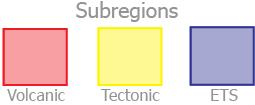Spectrograms
Seismic Spectrograms
Spectrograms are a different way of presenting seismic waveform data for human review and interpretation. Similar to seismograms they show seismic energy versus time, but also include information about the frequency content of the seismic waves. For a complete description of spectrograms, with keys to their interpretation, including examples see "What is a Spectrogram."
Source Types
We have grouped spectrograms into geographic regions to monitor two types of seismic sources. The source types are:
There is no difference in processing the data for the different source types, we have simply selected different sets of stations that we have found to be most informative.
The spectrograms sets for the different sources are subdivided into geographic regions, shown as boxes on the map. The spectrograms in each region may be viewed by clicking the sub-region box on the map and then clicking the link in the pop-up, or by clicking one of the region names below. Stations distributed around the periphery of our network are under Pacific Northwest region but a box for this is not rendered on the map. This group is the best to use for looking for spectrograms from distant earthquakes.
Regions
Legend
